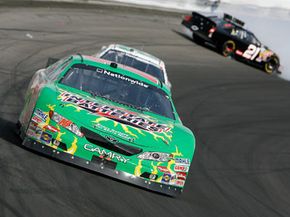Everyone knows what it feels like to hit their groove. Whether you're at work, playing sports, or even if you're grooving on the dance floor, finding your groove somehow seems to make the activity effortless. The same is true for NASCAR drivers.
But here's the difference: There are actually two types of grooves that NASCAR drivers can hit. There's the figurative groove, like the one we just mentioned where the driver's skills come together and his car seems to flow through the race effortlessly -- and then there's the literal groove. When someone says a NASCAR driver is in the groove, they generally don't mean that the driver is showcasing some flashy moves on the dance floor. They mean the driver is in the racing groove.
Advertisement
A racing groove is a term used to describe the best route around a race track. Since most NASCAR tracks are ovals, the racing groove is the fastest and most efficient route around the track. Being in the groove allows drivers to shave precious seconds off their time. There have been many times when a driver has been able to get into the groove, stay there and dominate the race.
But the groove isn't like the groove that slot car race tracks had when you were a kid. While the grooves at a NASCAR race track are usually visible, they aren't carved or dug into the surface of the track. If you want to spot a track's groove, look for a wide black line that follows each of the turns. Because NASCAR tires are designed to wear, they leave plenty of rubber on the track surface. Since most drivers want to stay in the groove, that rubber accumulates and ends up marking the groove. The extra rubber can sometimes provide drivers with more grip -- but at other times it can make the track more slippery. That's right -- the groove can change depending on race conditions.
We'll discuss that tricky factor in the upcoming pages, and learn about NASCAR tracks that have more than one racing groove. Keep reading to learn everything you've ever wanted to know about NASCAR racing grooves and more.
Advertisement







